Charles E W Bean, Diaries, AWM38 3DRL 606/5/1 - April - May 1915 - Part 7
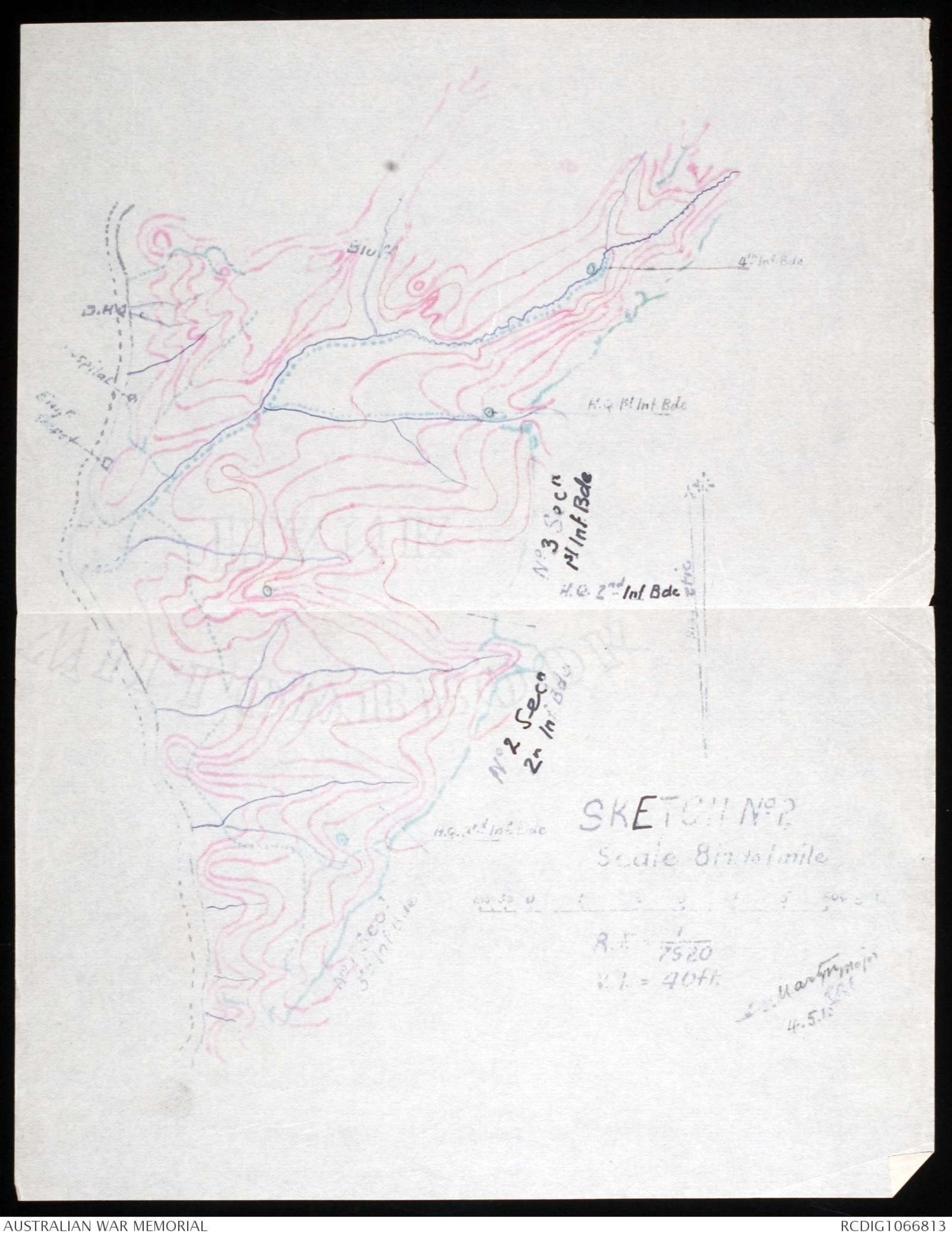
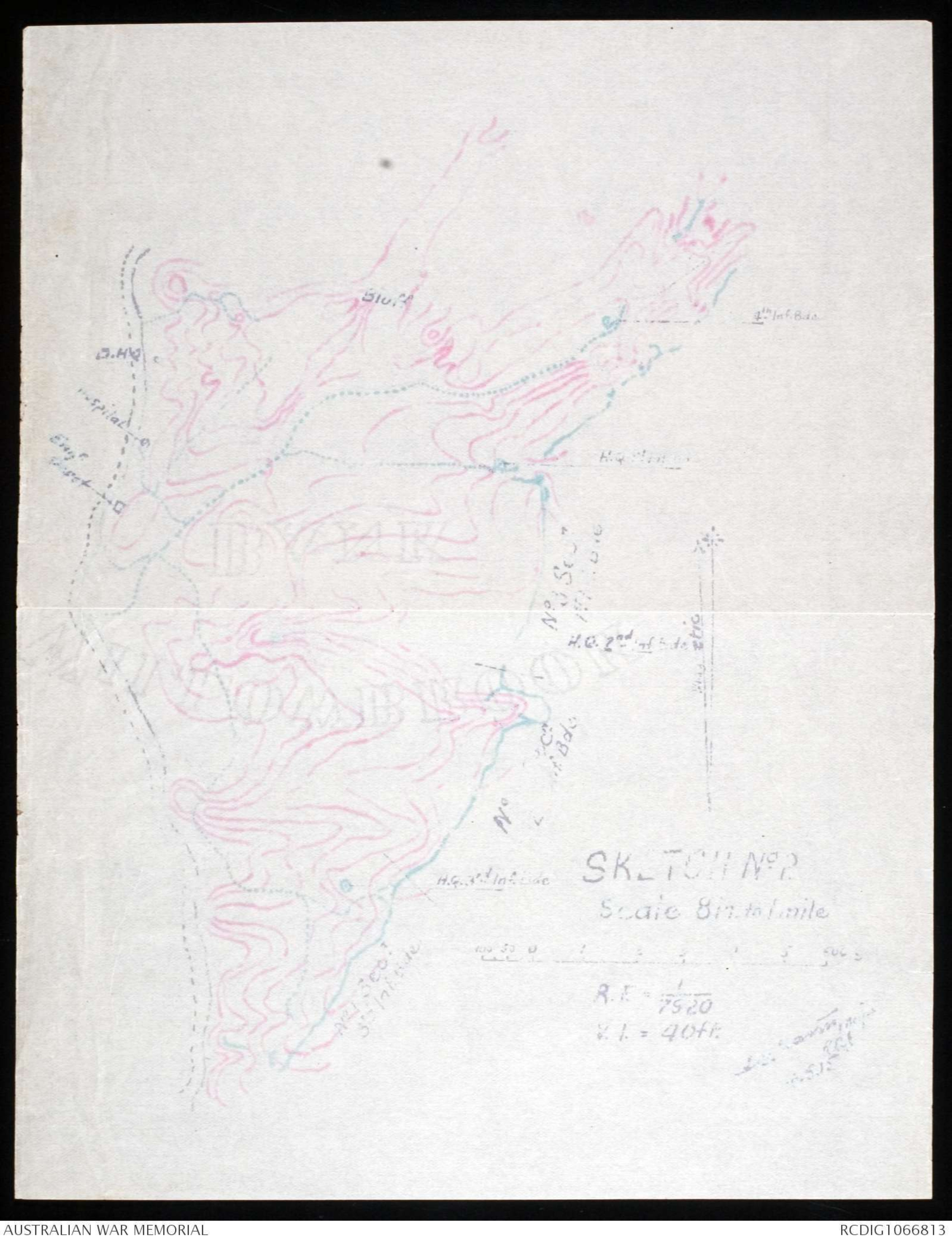
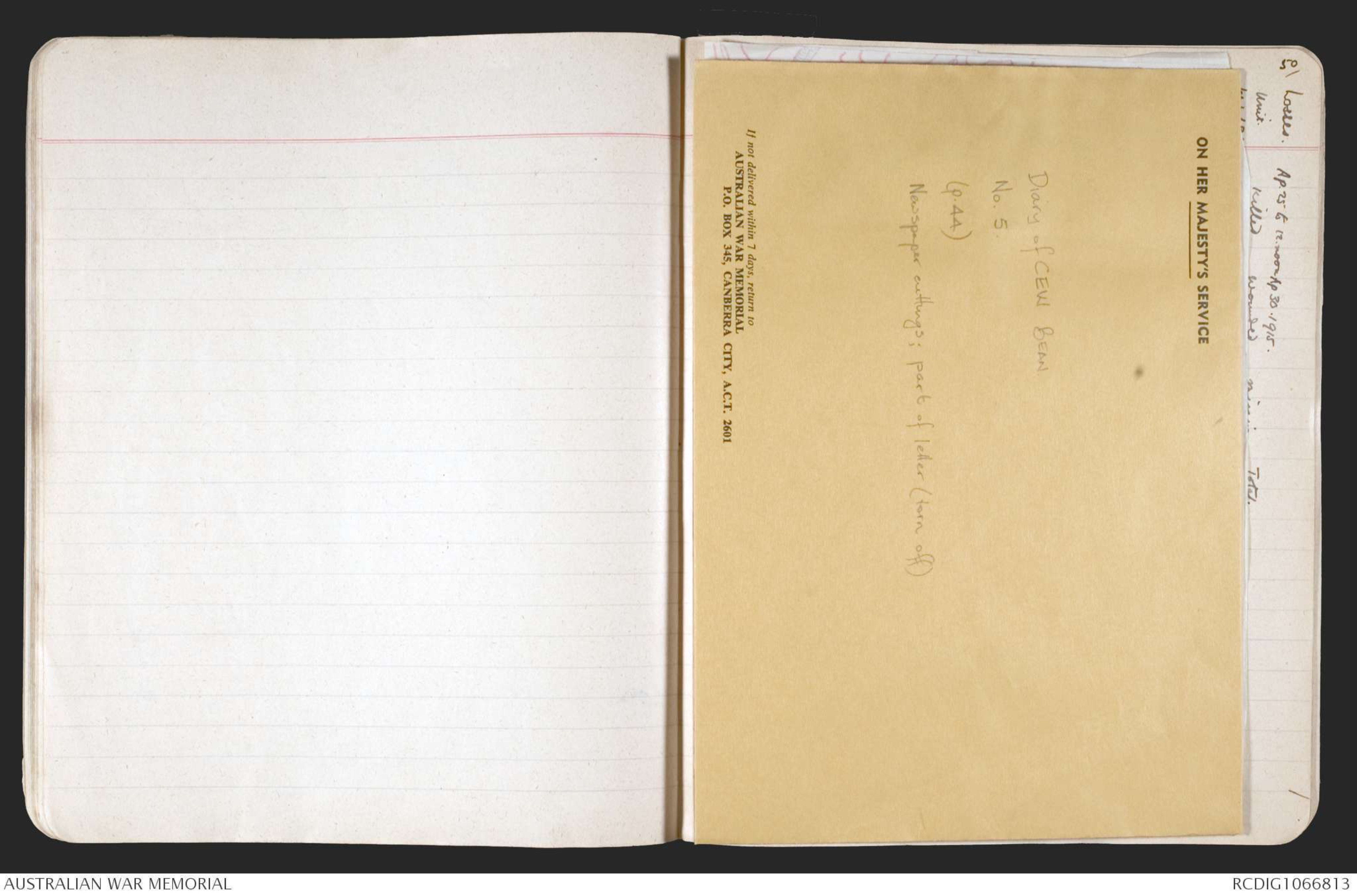
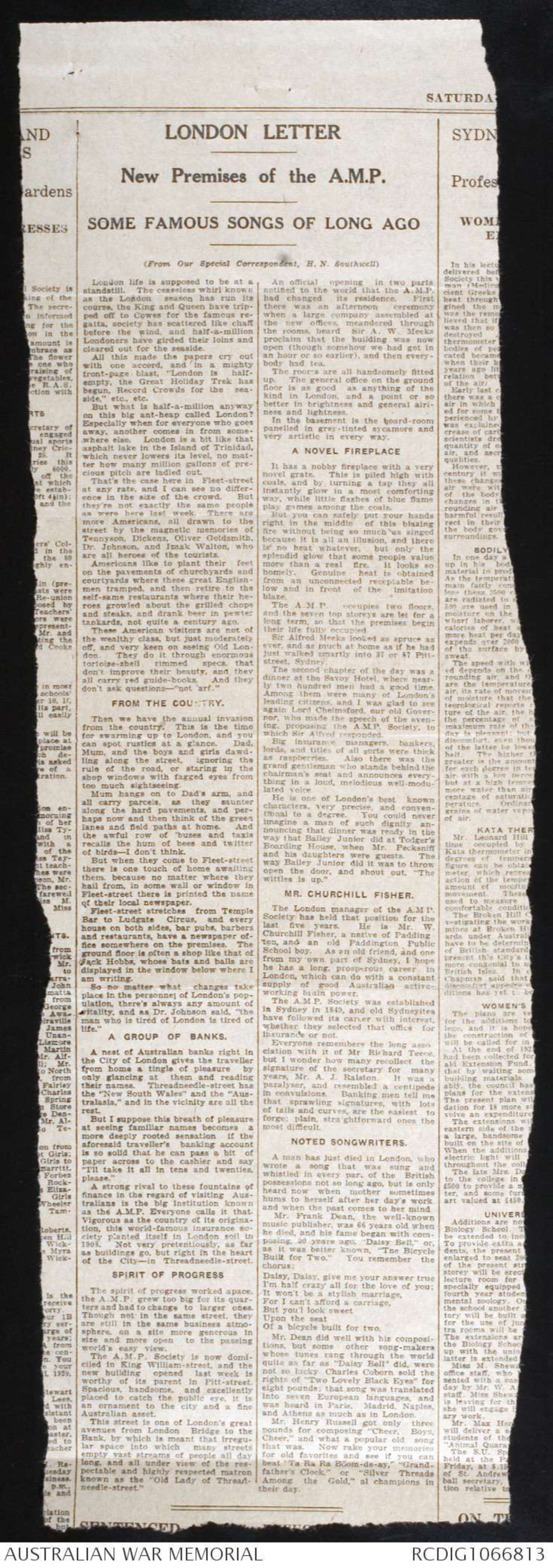
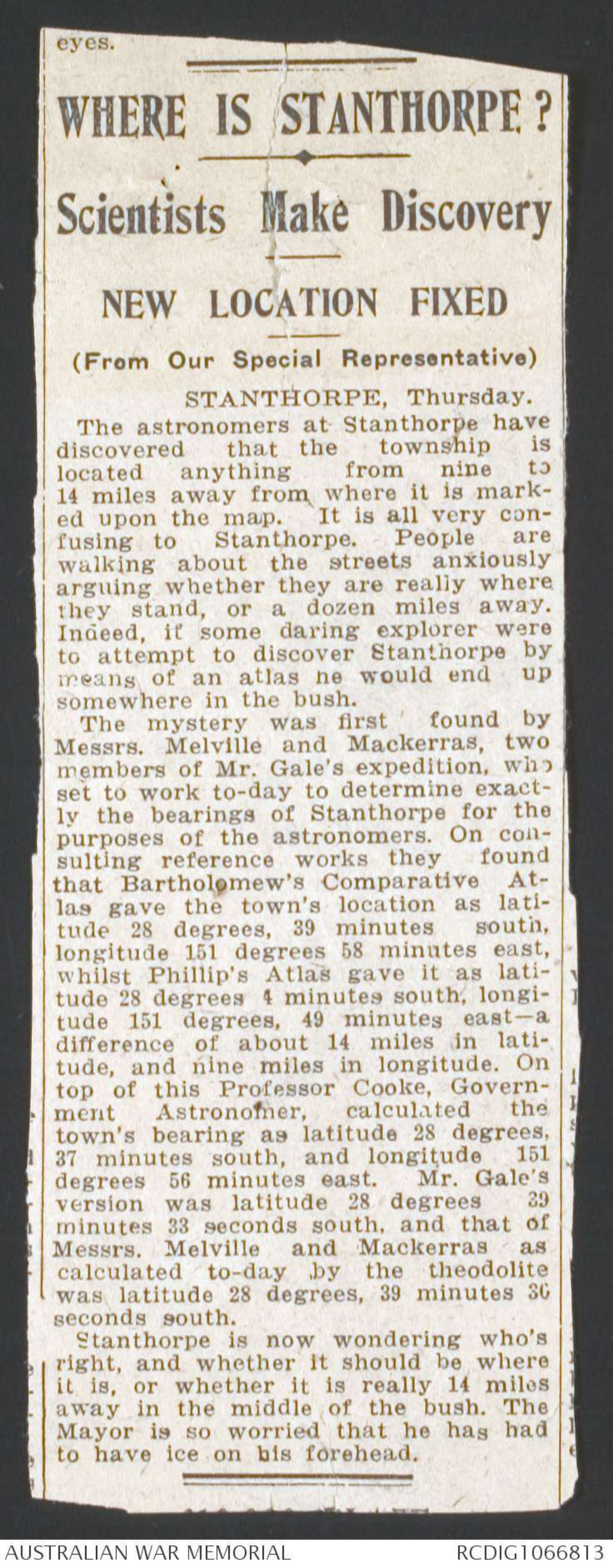
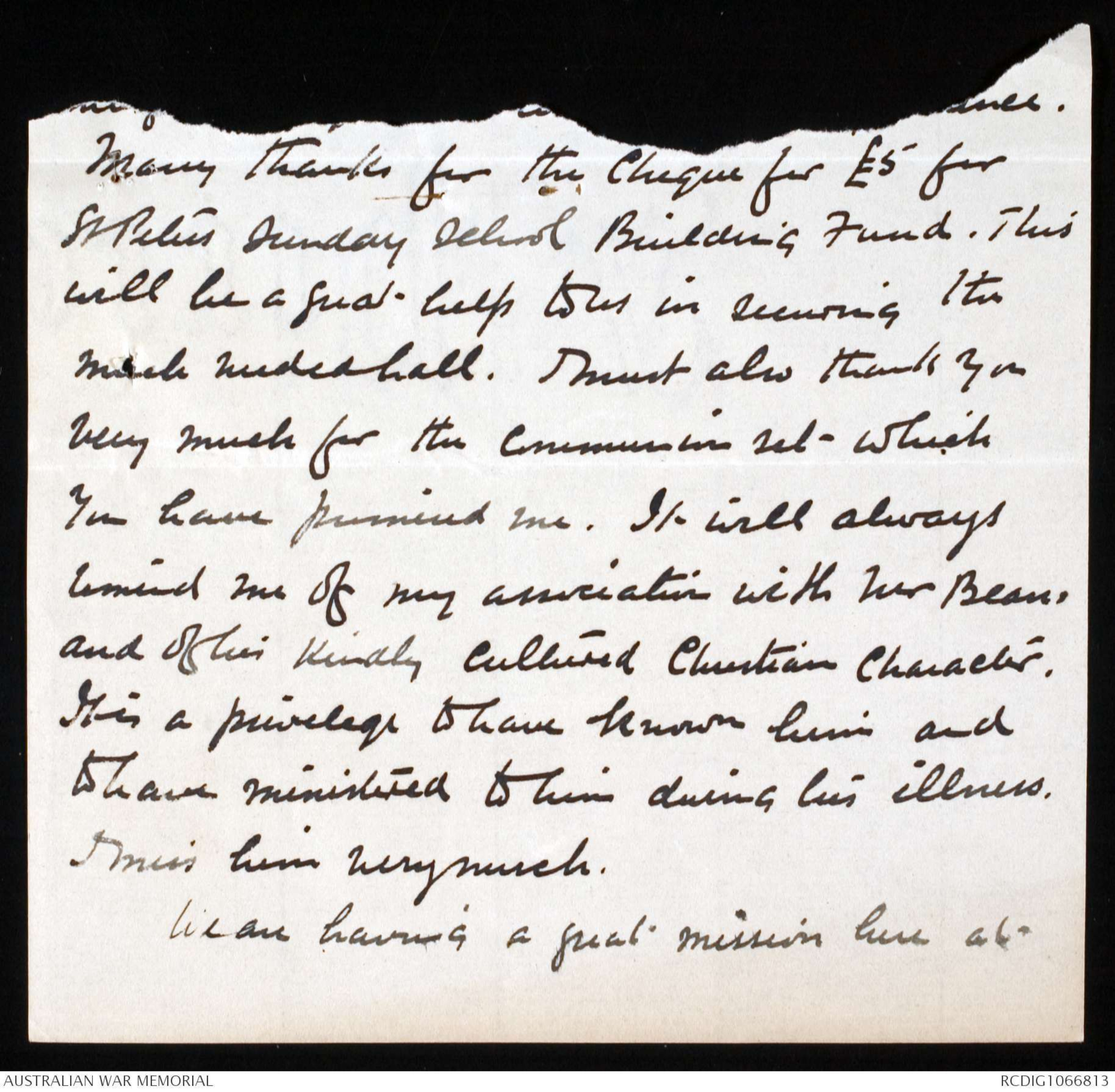
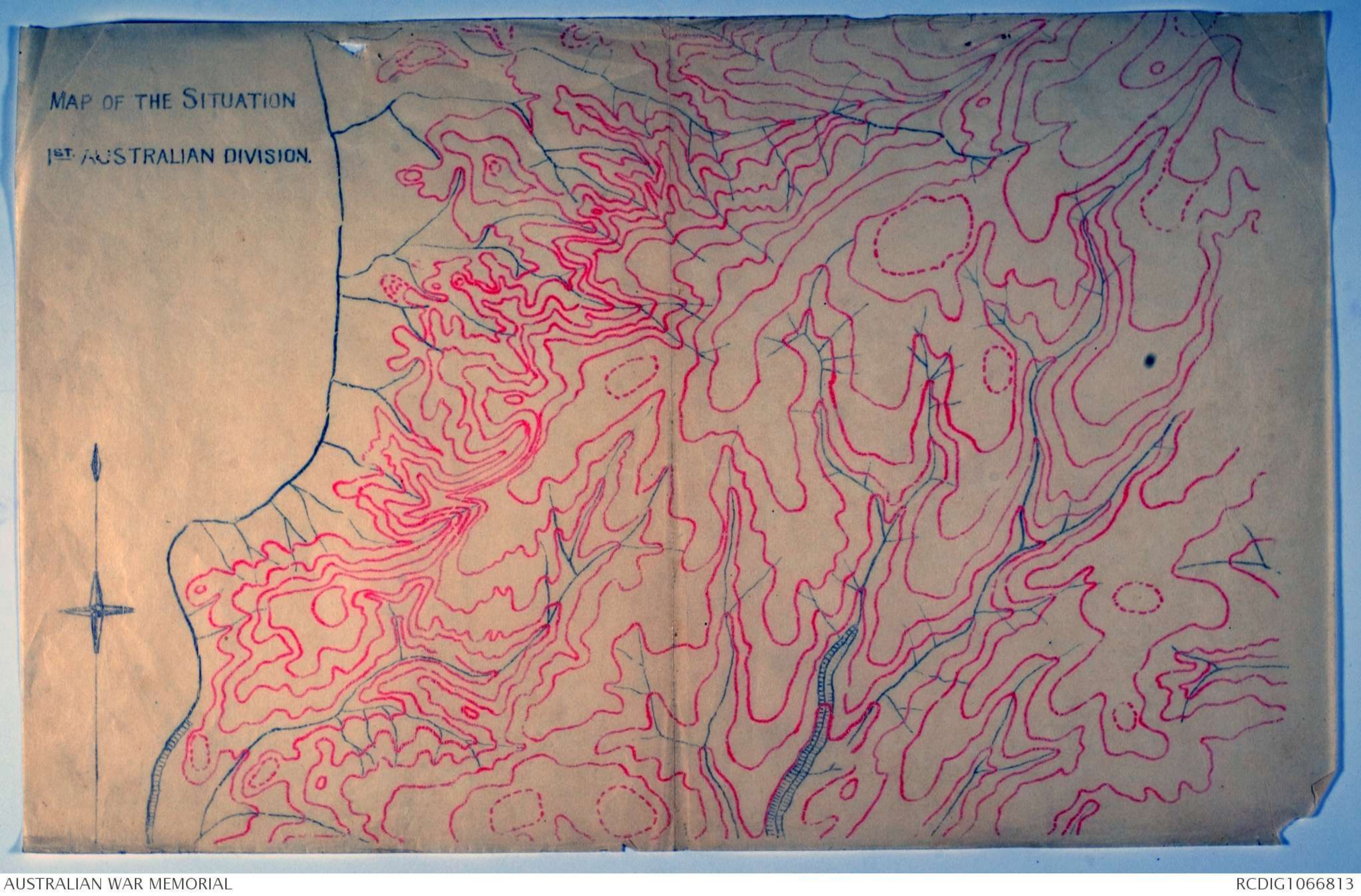
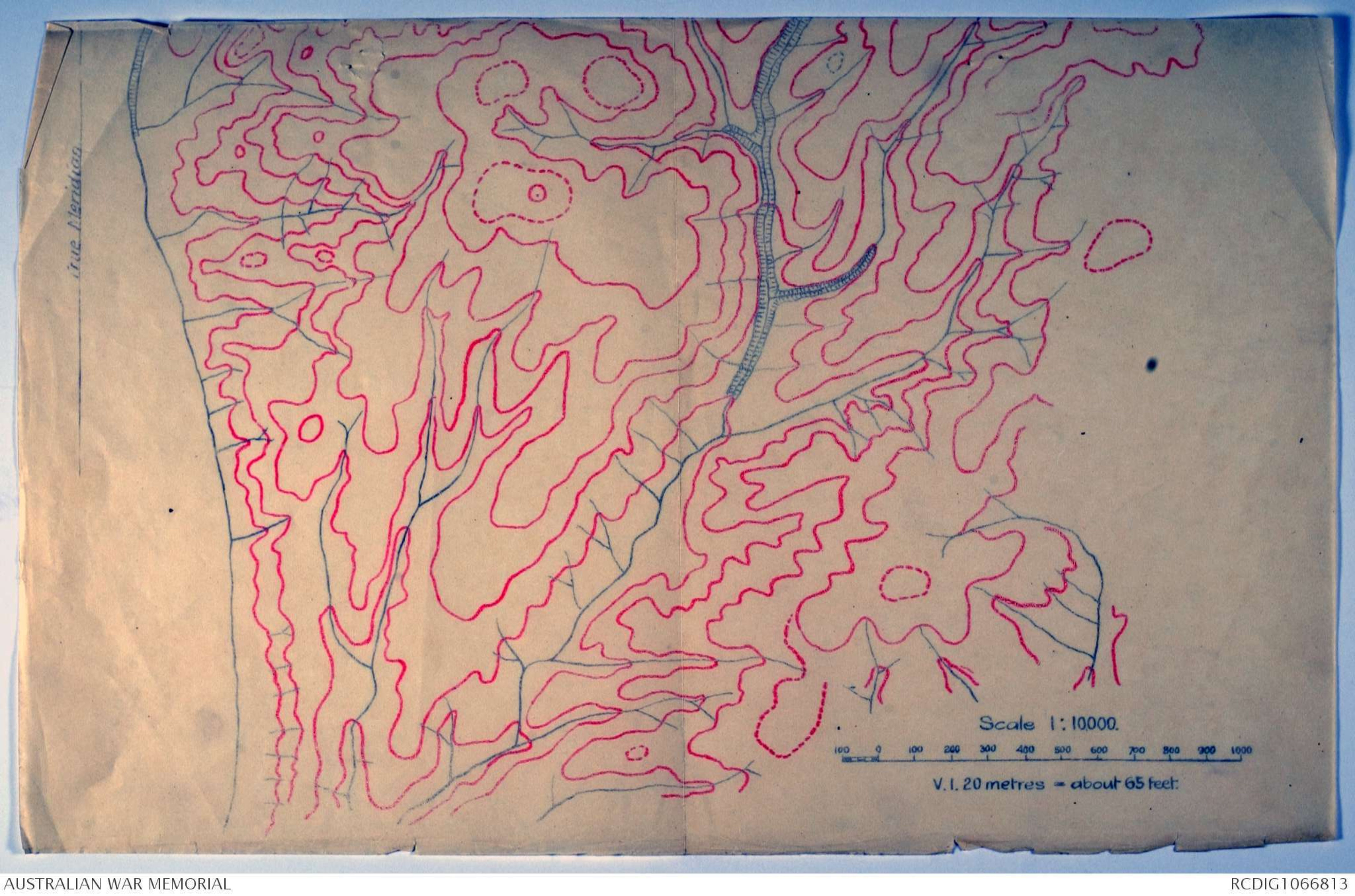
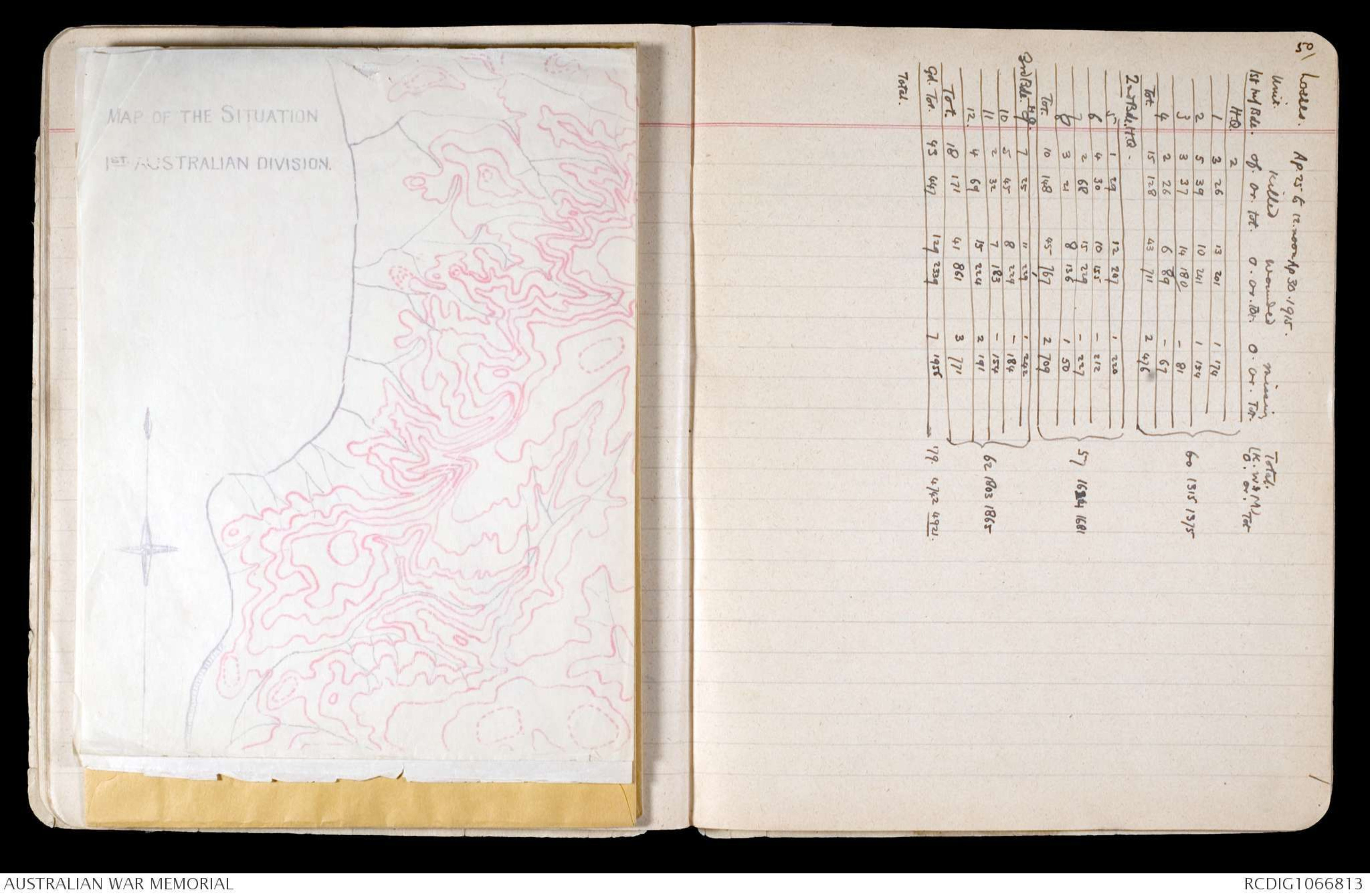
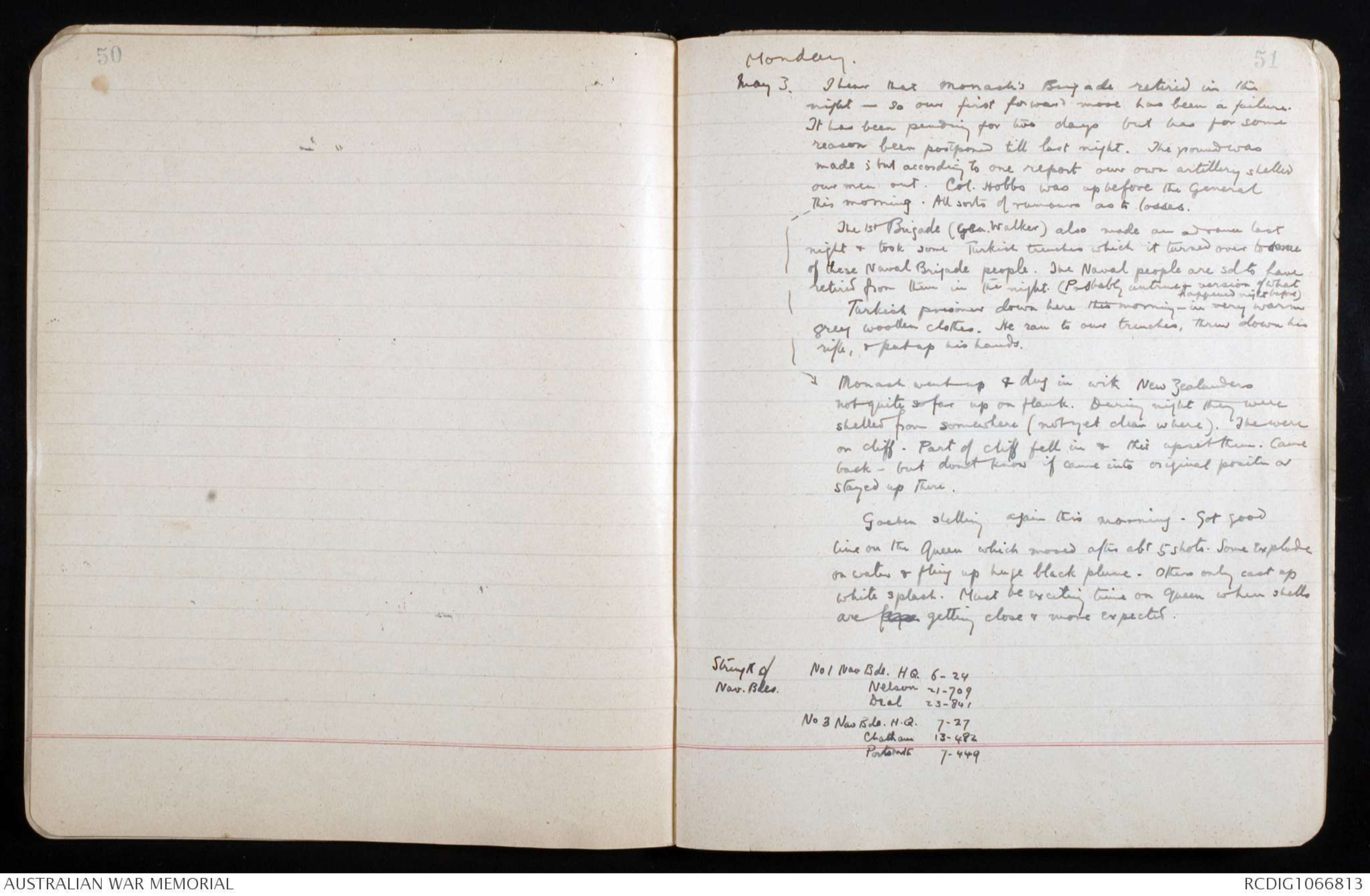
(Hand Drawn Diagram - titled Sketch No 2. Shows positions of 1st & 2nd Int Bde. Please see original document)
(Hand Drawn Diagram - another copy of Sketch No 2. Please see original document)
50
Losses. Ap. 25 to 12. noon Ap. 30. 1915
Unit. Killed Wounded Missing Total.
(Please note that the description below is of an envelope resting on Page 50. The above notation is written underneath on page 50 showing casualties and appears in full later)
ON HER MAJESTY'S SERVICE
Diary of CEW Bean
No.5.
(p.44)
Newspaper cuttings: part of letter (torn off)
If not delivered within 7 days, return to
AUSTRALIAN WAR MEMORIAL
P.O. BOX 345, CANBERRA CITY, A.C.T. 2601
(Please refer to the original document to see this page which is an article torn out of a newspaper. The illegible text appearing first and last is part wording along the newspapers torn edge. The main article commences LONDON LETTER)
Saturda
AND
S
ardens
resses
Society is
king of the
The secre-
n informed
ing for the
on in the
amount is
mbrace as
The flower
none who
raising of
vegetables,
e R.A.S.
ction with
RTS
cretary of
engaged
ual sports
ney Cric-
25. It
cries this
y 6000.
off the
at which
re estab-
0ft 4½in):
and the
ers' Col-
i in the
the 80
ghly en_
in )pre-
in (pre-
sts were
Re-union
osed by
Teachers'
ors were
represent-
Mr. and
ting thr
d Cooke
in most
schools
er 10. If,
its part,
ill easily
will be
place at
promise
ob de-
is asked
re of a
tration.
ion en-
morning
i of her
lissa Ty-
and in
with a
of the
Miss Tay-
nt teach-
hes were
pson Mr.
The sec-
farewell
Miss M.
Miss
WTS.
from
wick
Mr.
to
arra-
John
matta
from
George
Awa
iraville
James
Unan-
Lismore
Martin
Mr. Alf-
ll: Mr.
to North
from
Fairley
Charles
Spring
n Store
re Den-
Mr Al-
to Te-
on from
pt Girls:
Girls to
barrtit.
Forbes
Rock-
s Eliza-
Girls
Wheeler
tam-
Rorberts
en Hill
Wick-
n Myra
Wick-
is the
receive
orry
ur IB
ry ser-
rge of
years;
A from
ce con-
n. You
e your
L 1920.
Stewart
Lees.
d with
sistant
been
on at
aster.
ed to
eacher
Re_
uesday
siness.
p.m.
is and
ciation
of the
but
LONDON LETTER
New Premises of the A.MP.
SOME FAMOUS SONGS OF LONG AGO
(From Our Special Correspondent, H.N.Southscell)
London life is supposed to be at a
standstill. The ceaseless whirl known
as the London season has run its
course, the King and Queen have tripped
off to Cowes for the famous regatta,
society has scattered like chaff
before the wind, and half-a-million
Londoners have girded their loins and
cleared out for the seaside.
All this made the papers cry out
with one accord, and in a mighty
front-page blast," London is half-
empty, the Great Holiday Trek has
begun, Record Crowds for the sea-
side" etc.etc.
But what is half-a-million anyway
on this big ant-heap called London?
Especially when for everyone who goes
away, another comes in from somewhere
else. London is a bit like that
asphalt lake in the Island of Trinidad,
which never lowers its level no matter
how many million gallons of precious
pitch are ladled out.
That's the case here in Fleet-street
at any rate, and I can see no difference
in the size of the crowd. But
they're not exactly the same people
as were here last week. There are
more Americans, all drawn to the
street by magnetic memories of
Tennyson, Dickens, Oliver, Goldsmith,
Dr. Johnson, and Izaak Walton, who
are all heroes of the tourists.
Americans like to plant their feet
on the pavements of churchyards and
courtyards where these great Englishmen
tramped, and then retire to the
self-same restaurants where their
heroes growled about the grilled chops
and steaks, and drank beer in pewter
tankards, not quite a century ago.
These American visitors are not of
the wealthy class, but just moderately
off, and very keen on seeing Old London.
They do it through enormous
tortoise-shell rimmed specs, that
don't improve their beauty, and they
all carry red guide-books. And they
don't ask questions- "not 'arf."
From The Country
Then we have the annual invasion
from the country. This is the time
for swarming up to London, and you
can spot rustics at a glance. Dad,
Mum, and the boys and girls dawdling
along the street, ignoring the
rule of the road, or staring in the
shop windows with fagged eyes from
too much sightseeing.
Mum hangs on to Dad's arm, and
all carry parcels, as they saunter
along hard pavements, and perhaps
now and then think of the green
lanes and field paths at home. And
the awful row of 'buses and taxis
recalls the hum of bees and the twitter
of birds-I don't think.
But when they come to Fleet-street
there is one touch of home awaiting
them, because no matter where they
hail from, in some wall or window in
Fleet-street there is printed the name
of their local newspaper.
Fleet-street stretches from Temple
Bar to Ludgate Circus, and every
house on both sides, bar pubs, barbers
and restaurants, have a newspaper office
somewhere on the premises. The
ground floor is often a shop like that of
Jack Hobbs, whose bats and balls are
displayed in the window below where I
am writing.
So no matter what changes take
place in the personnel of London's
population, ther's always any amount of
vitality, and as Dr. Johnson said "the
man who is tired of London is tired of
life."
A Group Of Banks
A nest of Australian banks right in
the City of London gives the traveller
from home a tingle of pleasure by
only glancing at them and reading
their names. Threadneedle-street has
the "New South Wales' and the
"Australasia," and in the vicinity are all the
rest.
But I suppose this breath of pleasure
at seeing familiar names becomes a
more deeply rooted sensation if the
aforesaid traveller's banking account
is so solid that he can pass a bit of
paper across to the cashier and say
"I'll take it all in tens and twenties,
please."
A strong rival to these fountains of
finance in the regard of visiting
Australians is the big institution known
as the A.M.P. Everyone calls it that.
Vigorous as the country of its origination,
this world-famous insurance society
planted itself in London soil in
1908. Not very pretentiously, as far
as buildings go, but right in the heart
of the City - in Threadneedle-street.
Spirit of Progress
The spirit of progress worked apace,
the A.M.P. grew too big for its quarters
and had to change to larger ones.
Though not in the same street, they
are still in the same atmosphere,
on a site more generous in
size and more open to the passing
world's easy view.
The A.M.P. Society is now domiciled
in King William-street, and the
new building opened last week is
worthy of its parent in Pitt-street.
Spacious, handsome, and excellently
placed to catch the public eye, it is
an ornament to the city and a fine
Australian asset.
This street is one of London's great
avenues from London Bridge to the
Bank, by which is meant that irregular
space into which many streets
empty vast streams of people all day
long, and all under view of the
respectable and highly respected matron
known as the "Old Lady of Threadneedle-street."
An official opening in two parts
notified to the world that the A.M.P.
had changed its residence. First
there was an afternoon ceremony
when a large company assembled at
the new offices, meandered through
the rooms heard Sir.A.W. Meeks
proclaim that the building was now
open (although somehow we had got in
an hour or so earlier), and then everybody
had tea.
The rooms are all handsomely fitted
up. The general office on the ground
floor is as good as anything of the
kind in London, and a point or so
better in brightness and general
airiness and lightness.
In the basement is the board-room
panelled in grey-tinted sycamore and
very artistic in every way.
A NOVEL FIREPLACE
It has a nobby fireplace with a very
novel grate. This is piled high with
coals, and by turning a tap they all
instantly glow in a most comforting
way, while little flashes of blue flame
play games among the coals.
But you can safely put your hands
right in the middle of this blazing
fire without being so much as singed
because it is all an illusion, and there
is no heat whatever, but only the
splendid glow that some people value
more than a real fire. It looks so
homely. Genuine heat is obtained
from an unconnected receptable
below and in front of the imitation
blaze.
The A.M.P. occupied two floors,
and the seven top storeys are let for a
long term, so that the premises begin
their life fully occupied.
Sir Alfred Meeks looked as spruce as
ever, and as much at home as if he had
just walked smartly into 37 or 87 Pitt-
street, Sydney.
The second chapter of the day was a
dinner at the Savoy Hotel, where nearly
two hundred men had a good time.
Among them were many of London's
leading citizens, and I was glad to see
again Lord Chelmsford, our old Governor,
who made the speech of the evening,
proposing the A.M.P. Society, to
which Sir Alfred responded.
Big insurance managers, bankers,
lords, and titles of all sorts were thick
as raspberries. Also there was the
grand gentleman who stands behind the
chairman's seat and announces everything
in a loud, melodious well-modulated
voice.
He is one of London's best known
characters, very precise, and conventional
to a degree. You could never
imagine a man of such dignity announcing
that dinner was ready in the
way that Bailey Junior did at Todger's
Boarding House, when Mr Pecksniff
and his daughters were guests. The
way Bailey Junior did it was to throw
open the door and shout out,"The
wittles is up."
MR. CHURCHILL FISHER.
The London manager of the A.M.P.
Society has held that position for the
last five years. He is Mr. W.
Churchill Fisher, a native of Paddington,
and an old Paddington Public
School boy. As an old friend, and one
from my own part of Sydney, I hope
he has a long, prosperous career in
London, which can do with a constant
supply of good Australian active-
working brain power.
The A.M.P. Society was established
in Sydney in 1840, and old Sydneyites
have followed its career with interest,
whether they selected that office for
insurance or not.
Everyone remembers the long association
with it of Mr Richard Teece,
but I wonder how many recollect the
signature of the secretary for many
years, Mr.A.J. Ralston. It was a
paralyser, and resembled a centipede
in convulsions. Banking men tell me
that sprawling signatures, with lots
of tails and curves, are the easiest to
forge: plain, straightforward ones the
most difficult.
NOTED SONGWRITERS.
A man has just died in London, who
wrote a song that was sung and
whistled in every part of the British
possessions not so long ago, but is only
heard now when mother sometimes
hums to herself after her day's work
and when the past comes to her mind.
Mr. Frank Dean, the well-known
music publisher, was 66 years old when
he died, and his fame began with composing,
30 years ago, "Daisy Bell," or,
as it was better known, "The Bicycle
Built for Two." You remember the
chorus:
Daisy, Daisy, give me your answer true
I'm half crazy all for the love of you:
It won't be a stylish marriage,
For I can't afford a carriage,
But you'l look sweet
Upon the seat
Of a bicycle built for two.
Mr. Dean did well with his compositions,
but some other song-makers
whose tunes rang through the world
quite as far as "Daisy Bell" did, were
not so lucky. Charles Coborn sold the
rights of "Two Lovely Black Eyes" for
eight pounds; that song was translated
into seven European languages, and
was heard in Paris, Madrid, Naples,
and Athens as much as London.
Mr. Henry Russell got only three
pounds for composing "Cheer, Boys,
Cheer." and what a popular old song
that was. Now rake your memories
for old favorites and see if you can
beat "Ta Ra Ra Boom-de-ay," "Grandfathers's
Clock," or "Silver Threads
Among the Gold," al champions in their day.
SYDI
Profer
WoM
Saa
Tom
Roat through
anes the
wre the rome
Nored that
wne then oo
genngos
Ahermometor
bods ofN
cales becaen
when their
Jearn age H
relation Do
of the al
Early last o
ther wass
alr in watch
os for comne
perioncss by
wae oxitaine
crraw of car
adects &
quantity of a
atr. and
goni
Noworor
century
then he
Jannce
roonding ar
barmialr
rod to thel
the Boor
orroomr
CoOILY
in o
Maain
where
coms of
more beat pe
expents a
of the surtace t
ooat
remes
os depent
rounding an
are the tem
air. hs rate of mr
omoteinre that i
ture of the air. in
the pereoniage of
martinum rale
to mageen
Sonna
of 104
nott
Foal
for act
ar on
but .
moro
CoaE
persto
FaI
of an
KATA THE
Mr. Lwaard Hil
Ame oecapted by
Kain thermometer1
e of teaen
Doure can be osi
neles whih oor
acties of the teme
amount of mars
merement Thoad
ond to measure
be Ma
The Broken Hill C
troalis the eor
mines at Broton H
ards under Ausira
have to be determl
of Bolish ocandard
t
more oon
Brittsh ia
bentding
abtt. the coaned ha
plans for the exten
The present pln of
dation for 14 more &
rolve an expenditor
The extensions &
castern ade of the
a large handrom
buill on the site of
When the addition
olectre bebt vill
Chroghous the con
The lawe Mrs D
to the course in
0 to provide a7
ter and come fo
are valued an 11s0.
UNIVER
Addinous are no
Biotoey School.
bo extended to te
Te provide eatra
Seats the present
calarged to seal I
of the present on
morey will be are
Reclare room for
apoctally equipoos
fourth year owe
mental motegy.
tho ooanoihor
forr will be bork
for the an o
ire rooms will be
Tho orensone
the Broter &che
op with the unt
taner to extended
Mis M. Snon
Once SAH wo
maisd wp aoa
day by Mr. W
ma M She
t pertog for
the will ensage
or vork.
Mr. Max Nc
will deliver
andents of th
Animal Ouar
The RU.s
ots at the
Pridar at 5.1
of se Aodre
ball eriar
100 .
eyes.
(please refer to the original document to this news clipping)
WHERE IS STANTHORPE?
________
Scientists make Discovery
_____
NEW LOCATION FIXED
(From Our Special Representative)
STANTHORPE, Thursday.
The astronomers at Stanthorpe have
discovered that the township is
located anything from nine to
14 miles away from where it is mark-
ed upon the map. It is all very con-
fusing to Stanthorpe. People are
walking about the streets anxiously
arguing whether they are really where
they stand, or a dozen miles away.
Indeed, if some daring explorer were
to attempt to discover Stanthorpe by
means of an atlas he would end up
somewhere in the bush.
The mystery was first found by
Messrs. Melville and Mackerras, two
members of Mr. Gale's expedition, who
set to work to-day to determine exact-
ly the bearings of Stanthorpe for the
purposes of the astronomers. On con-
sulting reference works they found
that Bartholomew's Comparative At-
las gave the town's location as lati-
tude 28 degrees, 39 minutes south,
longitude 151 degrees 58 minutes east,
whilst Phillip's Atlas gave it as lati-
tude 28 degrees 4 minutes south, longi
tude 151 degrees, 49 minutes east—a
difference of about 14 miles in lati-
tude, and nine miles, in longitude. On
top of this Professor Cooke, Govern-
ment Astronomer, calculated the
town’s bearing as latitude 28 degrees,
37 minutes south, and longitude 151
degrees 56 minutes east. Mr. Gale's
version was latitude 28 degrees 39
minutes 33 seconds south, and that of
Messrs. Melville and Mackerras as
calculated to-day by the theodolite
was latitude 28 degrees, 39 minutes 36
seconds south.
Stanthorpe is now wondering who's
right, and whether it should be, where
it is, or whether it is really 14 miles
away in the middle, of the bush. The
Mayor is so worried that he has had
to have ice on his forehead.
_________________________
(Please refer to original document to see part page from a letter)
Many thanks for the Cheque for £5 for
St Peters Sunday School Building Fund. This
will be a great help to us in securing the
much needed hall. I must also thank you
very much for the communion set-which
you have promised me. It will always
remind me of my association with Mr Bean
and of his kindly cultured Christian Character.
It is a privilege to have known him and
to have ministered to him during his illness.
I miss him very much.
We are having a great mission here a
(Please refer to original document for copy of topographical map with heading)
Map of the Situation
1st Australian Division
(Please refer to original document for copy of topographical map)
(Please refer to original document for copy of folded map possibly contents of maps from previous two pages)
Map of the Situation
1st Australian Division
50
Losses Ap 25 to 12 noon Ap 30. 1915
Unit Killed Wounded Missing Total
1st Inf Bde Of Or Tot O Or Tot O Or Tot (K. W & M)
H.Q 2 O. Or. Tot
1 3 26 13 201 1 174
2 5 39 10 241 1 154 } 60 1315 1375
3 3 37 14 180 - 81
4 2 26 6 89 - 67
Tot. 15 128 43 711 2 476
2nd Bde. H.Q.
5 1 29 12 207 1 220
6 4 30 10 155 - 212
7 2 68 15 229 - 227 } 57 1624 1681
8 3 21 8 136 1 50
Tot. 10 148 45 767 2 709
H.Q 1
3rd Bde
9 7 25 11 229 1 242
10 5 45 8 229 - 184
11 2 32 7 183 - 154 } 62 1803 1865
12 4 69 15 224 2 191
Tot. 18 171 41 861 3 771
Gd. Tot. 43 447 129 2339 7 1956 179. 4742 4921
Total
Monday 51
May 3 I hear that Monash’s Brigade retired in the
night - so our first forward move has been a failure.
It has been pending for two days but has for some
reason been postponed till last night. The [[pound?]] was
made ; but according to one report our own artillery shelled
our men out. Col. Hobbs was up before the General
this morning. All sorts of rumours as to losses.
| The 1st Brigade (Gen. Walker) also made an advance last
| night & took some Turkish trenches which it turned over to some
| of these Naval Brigade people. The Naval people are said to have
| retired from them in the night (Probably untrue - version of what
| happened night before)
| Turkish prisoner down here to morning- in very warm
| grey woollen clothes. He ran to our trenches, threw down his
| rifle, & put up his hands.
|
↓ Monash went up & dug in with New Zealanders
not quite so far up on flank. During night they were
shelled from somewhere (not yet clear where). They were
on cliff. Part of cliff fell in & this upset them. Came
back - but don't know if came into original position or
stayed up there.
[[Gasten/German?]] shelling again this morning. Got good
line on the Queen which moved after abt 5 shots. Some exploded
on water + flung up huge black plume. Others only cast up
white splash. Must be exciting time on Queen when shells
are fall getting close & more expected
[*Strength of
Nav. Bdes.*]
No 1 Nav Bde. HQ 6-24
Nelson 21-709
Deal 23-841
No 3 Nav Bde. H.Q. 7-27
Chatham 13-492
Portsmouth 7-449
 Sherrie C
Sherrie CThis transcription item is now locked to you for editing. To release the lock either Save your changes or Cancel.
This lock will be automatically released after 60 minutes of inactivity.